CHECK HARNESS AND CONNECTOR (ECM - ETCS FUSE, ETCS FUSE - BATTERY)
DTC P2118 Throttle Actuator Control Motor Current Range / Performance
Description
The ETCS (Electronic Throttle Control System) has a dedicated power supply circuit. The voltage (+BM) is monitored and when it is low (below 4 V), the ECM determines that there is a malfunction in the ETCS and cuts off the current to the throttle actuator. When the voltage becomes unstable, the ETCS itself becomes unstable. For this reason, when the voltage is low, the current to the throttle actuator is cut. If repairs are made and the system returns to normal, turn the engine switch off. The ECM then allows the current to flow to the throttle actuator so that it can be restarted.
HINT:
The ETCS does not use a throttle cable.
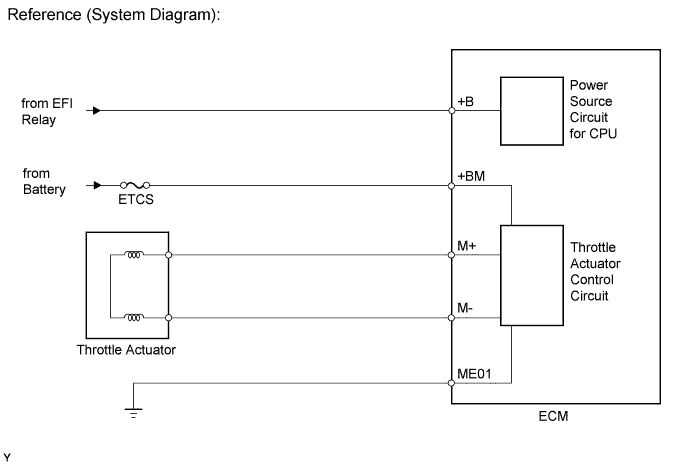
| DTC Code | DTC Detection Condition | Trouble Area |
| P2118 | An open in the ETCS power source (+BM) circuit (1 trip detection logic). |
|
Monitor description
The ECM monitors the battery supply voltage applied to the throttle actuator. When the power supply voltage (+BM) drops below 4 V for 0.8 seconds or more, the ECM interprets this as an open in the power supply circuit (+BM). The ECM illuminates the MIL and stores the DTC. If the malfunction is not repaired successfully, the DTC is stored 5 seconds after the engine is next started.
FAIL-SAFE
When this DTC, or other DTCs relating to ETCS (Electronic Throttle Control System) malfunctions are stored, the ECM enters fail-safe mode. During fail-safe mode, the ECM cuts the current to the throttle actuator, and the throttle valve is returned to a 7° throttle angle by the return spring. The ECM then adjusts the engine output by controlling the fuel injection (intermittent fuel cut) and ignition timing, in accordance with the accelerator pedal opening angle, to allow the vehicle to continue at a minimal speed. If the accelerator pedal is depressed firmly and gently, the vehicle can be driven slowly. Fail-safe mode continues until a pass condition is detected, and the engine switch is then turned off.
Wiring diagram
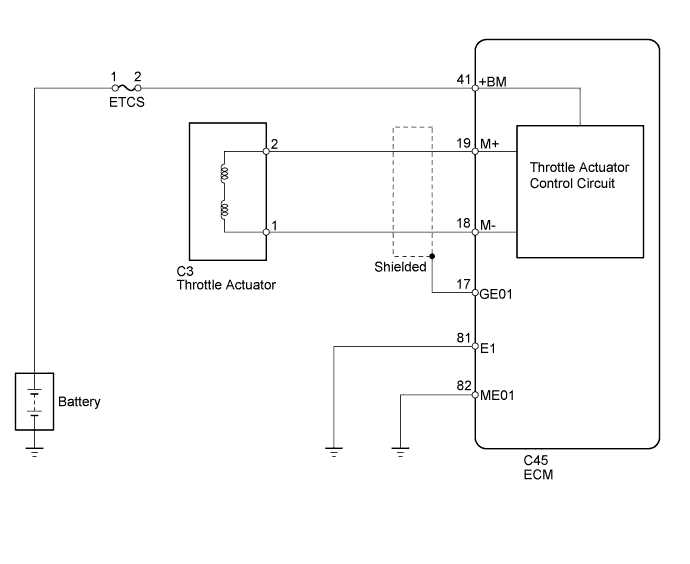
Inspection procedure
HINT:
Read freeze frame data using the intelligent tester. Freeze frame data records the engine condition when malfunctions are detected. When troubleshooting, freeze frame data can help determine if the vehicle was moving or stationary, if the engine was warmed up or not, if the air-fuel ratio was lean or rich, and other data from the time the malfunction occurred.
| 1.INSPECT FUSE (ETCS) |
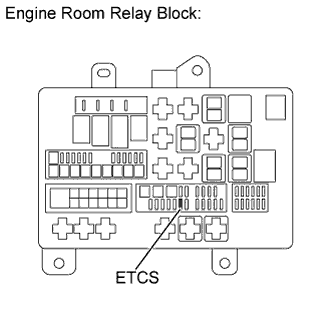
-
Remove the ETCS fuse from the engine room relay block.
-
Measure the resistance according to the value(s) in the table below.
Standard Resistance:
Tester Connection Condition Specified Condition ETCS fuse Always Below 1 ?
|
|
||||
| OK | |
| 2.CHECK HARNESS AND CONNECTOR (ECM - ETCS FUSE, ETCS FUSE - BATTERY) |
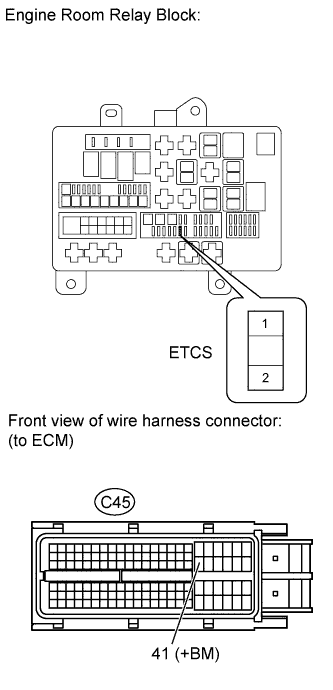
-
Check the harness and connector between the ETCS fuse and ECM.
-
Remove the ETCS fuse from the engine room relay block.
-
Disconnect the C45 ECM connector.
-
Measure the resistance according to the value(s) in the table below.
Standard Resistance:
Tester Connection Condition Specified Condition ETCS fuse terminal 2 - C45-41 (+BM) Always Below 1 ? ETCS fuse terminal 2 or C45-41 (+BM) - Body ground Always 10 k? or higher
-
-
Check the harness and connector between the ETCS fuse and positive battery cable.
-
Remove the ETCS fuse from the engine room relay block.
-
Disconnect the cable from the positive (+) battery terminal.
-
Measure the resistance according to the value(s) in the table below.
Standard Resistance:
Tester Connection Condition Specified Condition Positive battery cable - ETCS fuse terminal 1 Always Below 1 ? Positive battery cable or ETCS fuse terminal 1 - Body ground Always 10 k? or higher
-
|
|
||||
| OK | |
| 3.INSPECT ECM (+BM VOLTAGE) |
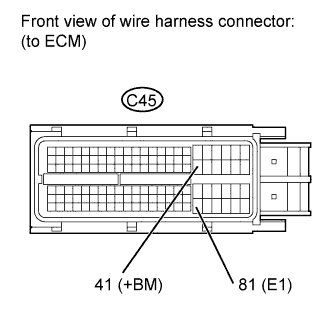
-
Disconnect the C45 ECM connector.
-
Measure the voltage according to the value(s) in the table below.
Standard Voltage:
Tester Connection Condition Specified Condition C45-41 (+BM) - C45-81 (E1) Always 11 to 14 V
|
|
||||
| OK | |
|